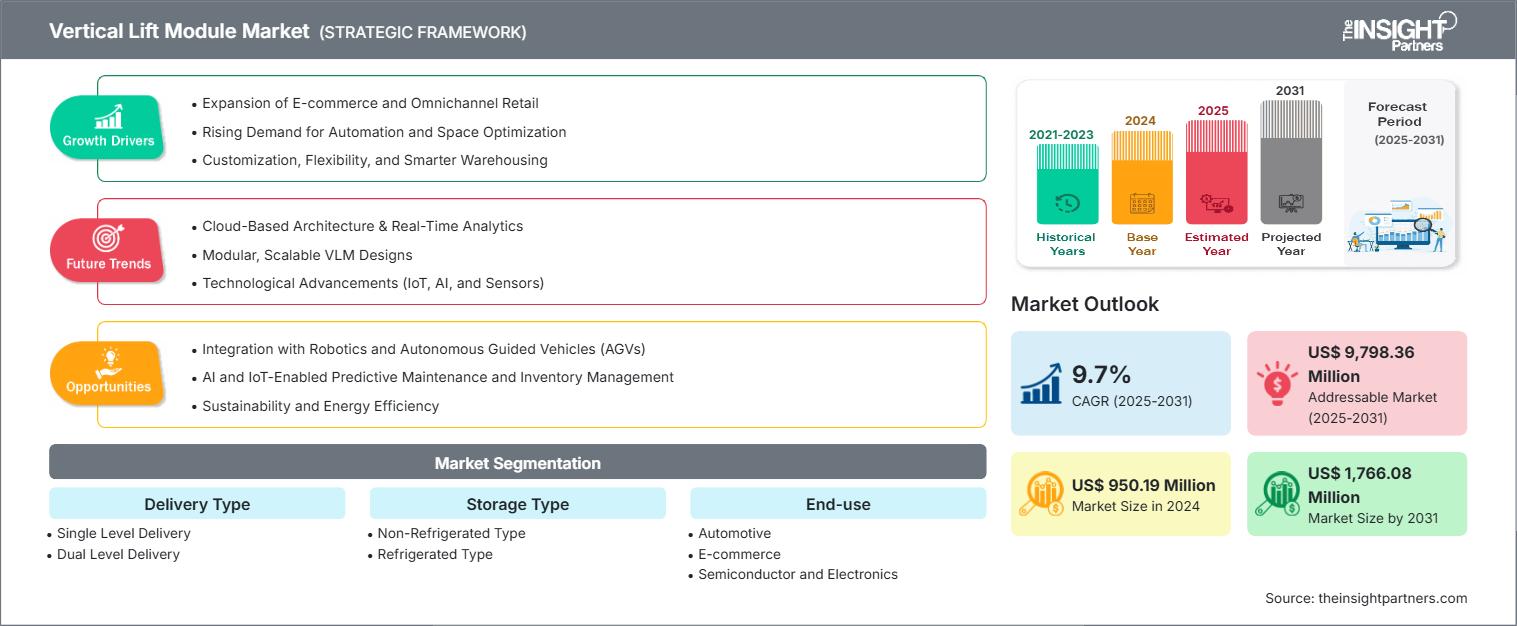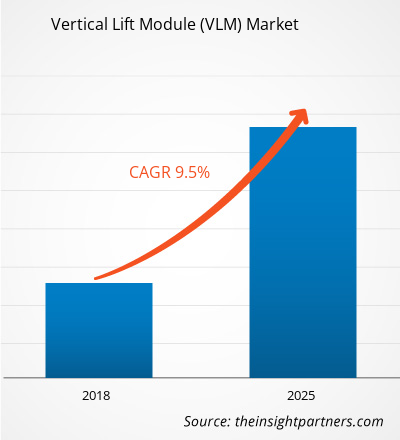Der globale Markt für vertikale Hebemodule belief sich im Jahr 2017 auf 808,5 Mio. USD und wird im Prognosezeitraum 2017–2025 voraussichtlich mit einer durchschnittlichen jährlichen Wachstumsrate von 9,5 % wachsen und im Jahr 2025 1667,6 Mio. USD erreichen.
Der Markt für vertikale Hebemodule hat in den letzten Jahren ein erhebliches Wachstum und eine hohe Akzeptanz erfahren und wird dies auch in den kommenden Jahren voraussichtlich tun. Die Region Asien-Pazifik ist die am schnellsten wachsende Region im E-Commerce-Bereich und treibt den Bedarf an und bietet Logistikunternehmen Möglichkeiten, den schnelllebigen Sektor zu bedienen. Die zunehmende Internet- und Mobilfunkdurchdringung, die steigende Zahl von E-Commerce-Akteuren sowie die zunehmenden Logistikoptionen in der Wertschöpfungskette haben dem E-Commerce-Sektor in der Region Auftrieb gegeben. Um in der dynamischen und schnelllebigen E-Commerce-Landschaft wettbewerbsfähig zu bleiben, müssen die Logistikunternehmen ihre Lagereinrichtungen und Lagerhallenabläufe neu erfinden. Angesichts der Vielzahl an Marktteilnehmern ist die Bewältigung der komplexen Kundenanforderungen und -erwartungen eine der größten Herausforderungen für Logistikunternehmen. Um diese Herausforderungen zu meistern, setzen Logistikunternehmen auf automatisierte Systeme, um ihre Lagerabläufe sowie die Sicherheit und den Komfort ihrer Mitarbeiter zu verbessern. Dank der verbesserten Raumnutzung durch VLMs und der verbesserten Bestandskontrolle steigt die Nachfrage nach solchen ASRS-Lösungen im schnell wachsenden Logistiksektor der APAC-Länder stark an. Für den Markt für Vertikalliftmodule im asiatisch-pazifischen Raum wird in den kommenden Jahren eine durchschnittliche jährliche Wachstumsrate (CAGR) von 12,02 % erwartet.
Passen Sie diesen Bericht Ihren Anforderungen an
Sie erhalten kostenlos Anpassungen an jedem Bericht, einschließlich Teilen dieses Berichts oder einer Analyse auf Länderebene, eines Excel-Datenpakets sowie tolle Angebote und Rabatte für Start-ups und Universitäten.
Markt für vertikale Hubmodule: Strategische Einblicke

-
Holen Sie sich die wichtigsten Markttrends aus diesem Bericht.Dieses KOSTENLOSE Beispiel umfasst Datenanalysen, die von Markttrends bis hin zu Schätzungen und Prognosen reichen.
Das weltweite Bevölkerungswachstum hat enorme Auswirkungen auf die Nachfrage nach zahlreichen Produktkategorien in der Automobil-, Pharma-, Einzelhandels-, Elektronik-, Lebensmittel- und Getränkeindustrie sowie vielen weiteren Branchen. Um dieser enorm steigenden Nachfrage gerecht zu werden, haben die Hersteller ihre Produktion deutlich gesteigert. VLM ist eine solche Lagerlösung, die durch die Stapelung des Materials in vertikalen Regalen über 80 % Bodenfläche einspart. Außerdem sind diese Lagersysteme so konzipiert, dass sie das gelagerte Produkt auf Knopfdruck und mit minimalem manuellen Aufwand an einen Bediener an einer ergonomisch günstig gelegenen Position liefern. Diese mühelose Lieferung führt zu Zeitersparnissen und einer deutlichen Produktivitätssteigerung am Arbeitsplatz
Wachsende E-Commerce-Branche bringt mehr automatisierte Lagerlösungen mit sich
Die Entwicklung der E-Commerce-Branche geht Hand in Hand mit dem Erfolg der automatisierten Lagerbranche. Die Produkte von E-Commerce-Händlern werden in Lagerhallen gelagert. Um den Zeitaufwand für das Sortieren und Lagern dieser Produkte zu reduzieren, scheinen vertikale Hubmodule die besten Werkzeuge zu sein. Der Einzug der Automatisierung in andere Branchen, darunter Fertigung, Marketing, Lieferkette und mehr, hat die Art und Weise, wie Geschäfte gemacht werden, revolutioniert. Jeder einzelne Aspekt wird nun durch geeignete Automatisierungsmechanismen ersetzt, die die Möglichkeit bieten, die Arbeitseffizienz und Produktivität zu steigern. Ein Anstieg der Nachfrage zwingt Unternehmen dazu, auf zeitsparende und effizientere Abläufe umzusteigen. Auch die E-Commerce-Branche erlebt derzeit Spitzenzeiten und ist einer der größten Nutzer automatisierter Lagersysteme. Diese Faktoren dürften den Markt für vertikale Hubmodule ankurbeln.
Markt für vertikale Hubmodule – Einblicke für Endnutzer
Die wichtigsten Endnutzer des Marktes für vertikale Hubmodule sind die Automobilindustrie, die Lebensmittel- und Getränkeindustrie, die Elektronikindustrie, der Einzelhandel, der E-Commerce, die Logistikindustrie, die Luft- und Raumfahrtindustrie, die Pharmaindustrie und weitere. In der Luft- und Raumfahrtindustrie ist ein hohes Maß an Kontrolle und Sicherheit üblich. Dasselbe gilt sogar für die an Produktionsstandorten gelagerten oder verwalteten Werkzeuge, Ersatzteile, Teile und Materialien. Einige Teile und Werkzeuge müssen sicher aufbewahrt werden, und wertvolle Vermögenswerte müssen geschützt und gelagert werden, um Diebstahl zu vermeiden und die Vertraulichkeit zu wahren. VLM-Lösungen bieten sichere Lagerung, indem sie den Zugriff des Bedieners auf die gelagerten Gegenstände physisch verhindern. Angesichts der zunehmenden Platzknappheit sucht die Luft- und Raumfahrtindustrie nach Techniken, um verfügbaren Platz in der Fertigungseinheit freizugeben. VLM hilft bei der Optimierung von Logistik und Prozessstrategien, um die Lagerung mit der verfügbaren Bodenfläche effizient zu verwalten. Daher wird prognostiziert, dass die Luft- und Raumfahrtindustrie im Markt für vertikale Hebemodule den Marktakteuren im Prognosezeitraum zahlreiche lukrative Geschäftsmöglichkeiten bieten wird.
Die Marktinitiative und Neuentwicklung wurde als die am häufigsten angewandte Strategie im globalen Markt für vertikale Hebemodule beobachtet. Einige der jüngsten Strategien einiger der auf dem Markt für vertikale Hebemodule tätigen Akteure sind unten aufgeführt:
2017: Hanel Storage Systems installierte 3 Lean-Lift-VLMs bei Productivity, Inc. in Minneapolis, USA. Productivity, Inc. ist ein Vertriebshändler für Werkzeugmaschinen und Werkzeugzubehör für die Metallverarbeitungsindustrie.
2016: EffiMat Storage Technology AS ging eine Partnerschaft mit ChinaSourcing E & T Co., Ltd ein, um das Vertriebsnetz des Unternehmens zu erweitern, indem ChinaSourcing zum alleinigen Vertriebshändler für EffiMats VLM in ganz Festlandchina ernannt wurde.
2016: Kardex Remstar setzte 18 Shuttle XP VLMs bei ALSO ein, einem in der Schweiz ansässigen IKT-Vertriebs- und Logistikunternehmen.
Regionale Einblicke in den Markt für vertikale Hubmodule (VLM)
Die Analysten von The Insight Partners haben die regionalen Trends und Faktoren, die den Markt für Vertikalliftmodule (VLM) im Prognosezeitraum beeinflussen, ausführlich erläutert. In diesem Abschnitt werden auch die Marktsegmente und die geografische Lage von Vertikalliftmodulen (VLM) in Nordamerika, Europa, im asiatisch-pazifischen Raum, im Nahen Osten und Afrika sowie in Süd- und Mittelamerika erörtert.
Umfang des Marktberichts zum Vertikalliftmodul (VLM)
| Berichtsattribut | Einzelheiten |
|---|---|
| Marktgröße in 2024 | US$ 950.19 Million |
| Marktgröße nach 2031 | US$ 1,766.08 Million |
| Globale CAGR (2025 - 2031) | 9.7% |
| Historische Daten | 2021-2023 |
| Prognosezeitraum | 2025-2031 |
| Abgedeckte Segmente |
By Lieferart
|
| Abgedeckte Regionen und Länder |
Nordamerika
|
| Marktführer und wichtige Unternehmensprofile |
|
Dichte der Marktteilnehmer für Vertikalliftmodule (VLM): Verständnis ihrer Auswirkungen auf die Geschäftsdynamik
Der Markt für Vertikal-Lift-Module (VLM) wächst rasant. Dies wird durch die steigende Endverbrauchernachfrage aufgrund veränderter Verbraucherpräferenzen, technologischer Fortschritte und eines stärkeren Bewusstseins für die Produktvorteile vorangetrieben. Mit der steigenden Nachfrage erweitern Unternehmen ihr Angebot, entwickeln Innovationen, um den Bedürfnissen der Verbraucher gerecht zu werden, und nutzen neue Trends, was das Marktwachstum weiter ankurbelt.

- Holen Sie sich die Markt für vertikale Hubmodule Übersicht der wichtigsten Akteure
Globaler Markt für vertikale Hebemodule – nach Endbenutzer
- Automobilindustrie
- Elektronik
- Lebensmittel und Getränke
- E-Commerce
- Luft- und Raumfahrt
- Logistik
- Pharmazeutika
- Einzelhandel
- Sonstige (Landwirtschaft, Bauwesen, Öl und Gas)
Globaler Markt für automatisierte Lagersysteme – nach Typ
- Einheitslader
- Minilader
- Karussells
- Vertikale Hebemodule (VLM)
- Sonstige
Globaler Markt für vertikale Hebemodule – Nach Geografie
-
Nordamerika
- USA
- Kanada
- Mexiko
-
Europa
- Frankreich
- Deutschland
- Italien
- Spanien
- Großbritannien
- Osteuropa
-
Asien-Pazifik (APAC)
- Japan
- China
- Indien
- Australien
-
Naher Osten und Afrika (MEA)
- Saudi-Arabien
- Südafrika
- VAE
-
Südamerika (SAM)
- Brasilien
- Argentinien
Markt für vertikale Hubmodule – Firmenprofile
- Hanel Storage Systems
- Interlake Mecalux, Kardex Group
- Lauyans and Co.
- Sapient Automation,
- SencorpWhite, System Logistics,
- Schaefer Systems International
- Effimat,
- Dexion,
- Modula
- Weland Lagersystems AB,
- Ferretto Group Spa
- ICAM SRL
- Historische Analyse (2 Jahre), Basisjahr, Prognose (7 Jahre) mit CAGR
- PEST- und SWOT-Analyse
- Marktgröße Wert/Volumen – Global, Regional, Land
- Branchen- und Wettbewerbslandschaft
- Excel-Datensatz
Aktuelle Berichte
Erfahrungsberichte
Grund zum Kauf
- Fundierte Entscheidungsfindung
- Marktdynamik verstehen
- Wettbewerbsanalyse
- Kundeneinblicke
- Marktprognosen
- Risikominimierung
- Strategische Planung
- Investitionsbegründung
- Identifizierung neuer Märkte
- Verbesserung von Marketingstrategien
- Steigerung der Betriebseffizienz
- Anpassung an regulatorische Trends






















 Kostenlose Probe anfordern für - Markt für vertikale Hubmodule
Kostenlose Probe anfordern für - Markt für vertikale Hubmodule